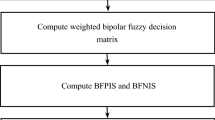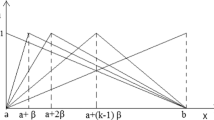Abstract
Most patients have more than one disease, and these diseases are able to affect one another. In modern medicine, the etiology and pathophysiology of diseases are well known in detail. However, inter-disease relationships are still mysterious. Physicians’ knowledge and experience have great importance in such a multi-criteria case. Because medical doctors in internal medicine clinics deal with large numbers of patients with multiple diseases, they have quite a complex approach in treating illness. In this context, exposing the cause-and-effect relationships among diseases frequently seen in internal medicine will contribute to physicians’ ability to blend profound theoretical knowledge with experiential results. Therefore, this study presents a fuzzy DEMATEL (Decision-Making Trial-and-Evaluation Laboratory) method to assess the most common diseases in internal medicine outpatient clinics. The DEMATEL method allows one to identify and analyze significant diseases in internal medicine by considering the cause-and-effect relationship diagram. Likewise, fuzzy sets in DEMATEL overcome the uncertainty in making decisions about disease relationships and internal medicine experts’ judgments. When investigating the results, we have found dyspepsia, hyperlipidemia, and anemia to be crucial in terms of causes. When evaluating the effects, the most notable diseases are understood to be renal failure, malignancy, and hepatitis. The results indicate that in the presented study, we could successfully apply these methods to reveal the cause–effect of diseases. The results of this study will contribute to understanding the complex multi-criteria relationship among internal diseases using internists’ opinions.




Similar content being viewed by others
References
Fauci, A. S., and others, Harrison’s principles of internal medicine, vol. 2. McGraw-Hill, Medical Publishing Division New York, 2008
Malani, P.N.: Harrison’s principles of internal medicine. JAMA 308(17), 1813–1814 (2012). https://doi.org/10.1001/jama.308.17.1813-b
Clarke, K., et al.: A methodology for evaluation of knowledge-based systems in medicine. Artif. Intell. Med. 6(2), 107–121 (1994). https://doi.org/10.1016/0933-3657(94)90040-X
Lucas, P.J.F.: Logic engineering in medicine. Knowl. Eng. Rev. 10(02), 153 (1995). https://doi.org/10.1017/S0269888900008134
Phuong, N.H., Kreinovich, V.: Fuzzy logic and its applications in medicine. Int. J. Med. Inform. 62(2–3), 165–173 (2001). https://doi.org/10.1016/S1386-5056(01)00160-5
Pandey, B., Mishra, R.B.: Knowledge and intelligent computing system in medicine. Comput. Biol. Med. 39(3), 215–230 (2009). https://doi.org/10.1016/j.compbiomed.2008.12.008
Gross, H.-J., Verwer, B., Houck, D., Hoffman, R.A., Recktenwald, D.: Model study detecting breast cancer cells in peripheral blood mononuclear cells at frequencies as low as 10 (-7). Proc. Natl. Acad. Sci. 92(2), 537–541 (1995). https://doi.org/10.1073/pnas.92.2.537
Ezzell, G.A.: Genetic and geometric optimization of three-dimensional radiation therapy treatment planning. Med. Phys. 23(3), 293–305 (1996). https://doi.org/10.1118/1.597660
Arabasadi, Z., Alizadehsani, R., Roshanzamir, M., Moosaei, H., Yarifard, A.A.: Computer aided decision making for heart disease detection using hybrid neural network-Genetic algorithm. Comput. Methods. Program. Biomed. 141, 19–26 (2017). https://doi.org/10.1016/j.cmpb.2017.01.004
Mahfouf, M., Abbod, M.F., Linkens, D.A.: A survey of fuzzy logic monitoring and control utilisation in medicine. Artif. Intell. Med. 21(1–3), 27–42 (2001). https://doi.org/10.1016/S0933-3657(00)00072-5
Bates, J.H., Young, M.P.: Applying fuzzy logic to medical decision making in the intensive care unit. Am. J. Respir. Crit. Care Med. 167(7), 948–952 (2003). https://doi.org/10.1164/rccm.200207-777CP
Barro, S., Marín, R.: Fuzzy logic in medicine, vol. 83. Physica-Verlag, New York (2013)
Korenevskiy, N.: Application of fuzzy logic for decision-making in medical expert systems. Biomed. Eng. 49(1), 46–49 (2015). https://doi.org/10.1007/s10527-015-9494-x
Lee, C.-C.: Fuzzy logic in control systems: fuzzy logic controller. I. IEEE. Transac. Syst. Man. Cybern. 20(2), 404–418 (1990). https://doi.org/10.1109/21.52551
Ross, T.J.: Fuzzy logic with engineering applications. Wiley, Hoboken (2009)
Susilawati, A., Tan, J., Bell, D., Sarwar, M.: Fuzzy logic based method to measure degree of lean activity in manufacturing industry. J. Manuf. Syst. 34, 1–11 (2015). https://doi.org/10.1016/j.jmsy.2014.09.007
Karatop, B., Kubat, C., Uygun, Ö.: Talent management in manufacturing system using fuzzy logic approach. Comput. Ind. Eng. 86, 127–136 (2015). https://doi.org/10.1016/j.cie.2014.09.015
Başhan, V., Demirel, H.: Evaluation of critical operational faults of marine diesel generator engines by using DEMATEL method. J. ETA. Marit. Sci. 6(2), 119–128 (2018). https://doi.org/10.5505/jems.2018.24865
Başhan, V., Demirel, H.: Application of fuzzy dematel technique to assess most common critical operational faults of marine boilers. Politeknik. Dergisi. 22(3), 545–555 (2019). https://doi.org/10.2339/politeknik.426644
Krishnapuram, R., Keller, J.M.: A possibilistic approach to clustering. IEEE. Trans. Fuzzy. Syst. 1(2), 98–110 (1993). https://doi.org/10.1109/91.227387
Vaidyanathan, M., et al.: Comparison of supervised MRI segmentation methods for tumor volume determination during therapy. Magn. Reson. Imag. 13(5), 719–728 (1995). https://doi.org/10.1016/0730-725X(95)00012-6
Yao, J., Dash, M., Tan, S., Liu, H.: Entropy-based fuzzy clustering and fuzzy modeling. Fuzzy. Sets. Syst. 113(3), 381–388 (2000)
Shieh, J.-I., Wu, H.-H., Huang, K.-K.: A DEMATEL method in identifying key success factors of hospital service quality. Knowl.-Based. Syst. 23(3), 277–282 (2010). https://doi.org/10.1016/j.knosys.2010.01.013
Liu, H.-C., You, J.-X., Lu, C., Chen, Y.-Z.: Evaluating health-care waste treatment technologies using a hybrid multi-criteria decision making model. Renew. Sustain. Energy. Rev. 41, 932–942 (2015). https://doi.org/10.1016/j.rser.2014.08.061
Ghadami, L., Masoudi, I., Hessam, S., Modiri, M.: Developing hospital accreditation standards: applying fuzzy DEMATEL. Int. J. Healthc. Manag. (2019). https://doi.org/10.1080/20479700.2019.1702307
Mahmoudi, S., Jalali, A., Ahmadi, M., Abasi, P., Salari, N.: Identifying critical success factors in Heart Failure Self-Care using fuzzy DEMATEL method. Appl. Soft. Comput. 84, 105729 (2019). https://doi.org/10.1016/j.asoc.2019.105729
Nilashi, M., et al.: Factors influencing medical tourism adoption in Malaysia: a DEMATEL-Fuzzy TOPSIS approach. Comput. Ind. Eng. 137, 106005 (2019). https://doi.org/10.1016/j.cie.2019.106005
Zhu, T., Luo, L., Liao, H., Zhang, X., Shen, W.: A hybrid multi-criteria decision making model for elective admission control in a Chinese public hospital. Knowl. Based. Syst. 173, 37–51 (2019). https://doi.org/10.1016/j.knosys.2019.02.020
Jiang, S., Shi, H., Lin, W., Liu, H.-C.: A large group linguistic Z-DEMATEL approach for identifying key performance indicators in hospital performance management. Appl. Soft. Comput. 86, 105900 (2020). https://doi.org/10.1016/j.asoc.2019.105900
Jeng, D.J.-F., Tzeng, G.-H.: Social influence on the use of clinical decision support systems: revisiting the unified theory of acceptance and use of technology by the fuzzy DEMATEL technique. Comput. Ind. Eng. 62(3), 819–828 (2012). https://doi.org/10.1016/j.cie.2011.12.016
Reyna, V.F., Lloyd, F.J.: Physician decision making and cardiac risk: effects of knowledge, risk perception, risk tolerance, and fuzzy processing. J. Exp. Psychol. Appl. 12(3), 179–195 (2006). https://doi.org/10.1037/1076-898X.12.3.179
Fathi-Torbaghan, M., Meyer, D.: MEDUSA: a fuzzy expert system for medical diagnosis of acute abdominal pain. Methods. Inf. Med. 33(05), 522–529 (1994). https://doi.org/10.1055/s-0038-1635055
Abbod, M.F., von Keyserlingk, D.G., Linkens, D.A., Mahfouf, M.: Survey of utilisation of fuzzy technology in Medicine and Healthcare. Fuzzy. Sets. Syst. 120(2), 331–349 (2001). https://doi.org/10.1016/S0165-0114(99)00148-7
Adlassnig, K.-P.: A fuzzy logical model of computer-assisted medical diagnosis. Methods. Inf. Med. 19(03), 141–148 (1980)
Adlassnig, K.-P.: Fuzzy set theory in medical diagnosis. IEEE. Transact. Syst. Man. Cybern. 16(2), 260–265 (1986). https://doi.org/10.1109/TSMC.1986.4308946
Zadeh, L. A., “Fuzzy sets,” In Fuzzy Sets, Fuzzy Logic, And Fuzzy Systems: Selected Papers by Lotfi A Zadeh, World Scientific, 1996, pp. 394–432
Chen-Yi, H., Ke-Ting, C., Gwo-Hshiung, T.: FMCDM with fuzzy DEMATEL approach for customers’ choice behavior model. Int. J. Fuzzy. Syst. 9(4), 545–555 (2007)
Wu, W.-W., Lee, Y.-T.: Developing global managers’ competencies using the fuzzy DEMATEL method. Expert Syst. Appl. 32(2), 499–507 (2007)
Liou, J.J., Yen, L., Tzeng, G.-H.: Building an effective safety management system for airlines. J. Air. Transp. Manag. 14(1), 20–26 (2008). https://doi.org/10.1016/j.jairtraman.2007.10.002
Akyuz, E., Celik, E.: A fuzzy DEMATEL method to evaluate critical operational hazards during gas freeing process in crude oil tankers. J. Loss Prev. Process Ind. 38, 243–253 (2015). https://doi.org/10.1016/j.jlp.2015.10.006
Başhan, V., Ust, Y.: Application of fuzzy dematel method to analyse s-CO2 Brayton power systems. IFS 37(6), 8483–8498 (2019). https://doi.org/10.3233/JIFS-191133
Gumus, A.T., Yayla, A.Y., Çelik, E., Yildiz, A.: A combined fuzzy-AHP and fuzzy-GRA methodology for hydrogen energy storage method selection in Turkey. Energies 6(6), 3017–3032 (2013). https://doi.org/10.3390/en6063017
Ward, B.W., Schiller, J.S.: Prevalence of multiple chronic conditions among US adults: estimates from the National Health Interview Survey, 2010. Prev. Chronic. Dis. 10, 120203 (2013). https://doi.org/10.5888/pcd10.120203
Shams, S., et al.: The prevalence of iron deficiency anaemia in female medical students in Tehran. Singapore Med. J. 51(2), 116 (2010)
Guyton, A.C., Hall, J.E.: Textbook of medical physiology. Elsevier Saunders, Philadelphia (2006)
Acknowledgements
The authors would like to thank engineer Mr. Veysi Başhan (Research Assistant at Yildiz Technical University, Istanbul, Turkey) for sharing his profound knowledge about the application of the fuzzy DEMATEL method.
Author information
Authors and Affiliations
Corresponding author
Ethics declarations
Conflict of interest
The authors declare that they have no competing interests. This research did not receive any specific grant. No funding used. No conflict of interest declared.
Additional information
Publisher's Note
Springer Nature remains neutral with regard to jurisdictional claims in published maps and institutional affiliations.
Rights and permissions
About this article
Cite this article
Suzan, V., Yavuzer, H. A Fuzzy Dematel Method To Evaluate The Most Common Diseases In Internal Medicine. Int. J. Fuzzy Syst. 22, 2385–2395 (2020). https://doi.org/10.1007/s40815-020-00921-x
Received:
Revised:
Accepted:
Published:
Issue Date:
DOI: https://doi.org/10.1007/s40815-020-00921-x




